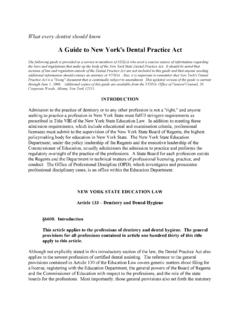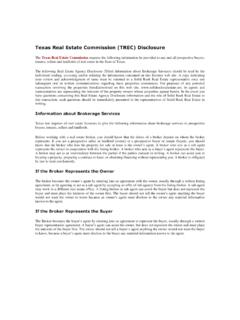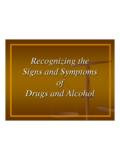Transcription of Occupational Health and Safety Act
1 A Guide to the Occupational Health and Safety Act A Guide to the Occupational Health and Safety Act October 2012 The Guide and other Guides, Statutes and Regulations relating to Occupational Health and Safety may also be viewed at the following website: A hardcopy of this publication can be ordered: Online at By phone through the ServiceOntario Contact Centre Monday to Friday, 8:30 am to 5:00 pm 416-326-5300 416-325-3408 (TTY) 1-800-668-9938 Toll-free across Canada 1-800-268-7095 TTY Toll-free across Ontario ISBN 978-1-4606-0063-4 (Print) Rev.
2 10/12 ISBN 978-1-4606-0064-1 (HTML) ISBN 978-1-4606-0065-8 (PDF) Queen s Printer for Ontario, 2012 Table of Contents v Introduction .. vi About this Guide .. 1 The Internal Responsibility System A Workplace Partnership .. 3 The Three Rights of 5 The Right to Know .. 5 The Right to Participate .. 6 The Right to Refuse .. 6 About the Act .. 7 Terms Used .. 7 Part I: Application .. 10 Work and Workplaces Not Covered .. 10 Part II: 12 Joint Health and Safety Committees (JHSCs) .. 12 The Function and Powers of the 13 Employer's Duty to Co-operate with the Committee.
3 16 Certified Members of Committees .. 17 Worker Trades Committees on Construction 18 Health and Safety Representatives .. 19 The Function and Powers of the Health and Safety 19 Employer's Duty to Co-operate with the Health and Safety 22 Part : Prevention Council, Chief Prevention Officer and Designated Entities .. 24 Part III: Duties of Employers and Other Persons .. 26 General Duties of Employers .. 26 Prescribed Duties of Employers .. 29 i Duties of Employers with respect to Workplace Violence and Workplace Harassment .. 29 Duties of Employers Concerning Toxic Substances .. 29 Duties of 29 Duties of Constructors.
4 31 Duties of Owners .. 32 Duties of Owners and Constructors Concerning Designated Substances on Construction Projects .. 33 Duties of 34 Duties of Licensees .. 34 Duties of Corporate Officers and Directors .. 35 Contraventions by Architects and Engineers .. 35 Duties of Workers .. 35 Part : Workplace Violence and Workplace Harassment .. 37 Workplace Harassment .. 38 Workplace Violence .. 39 Policies .. 39 Programs .. 39 Specific Duties Regarding Provision of Information and Instruction on Workplace Violence .. 40 Assessment of Risks for Workplace Violence .. 41 Domestic Violence .. 42 General Duties and Application to Workplace Violence.
5 43 Other Related Information and Instruction 43 Work Refusal Associated with Workplace Violence .. 44 Part : Codes of 45 Part IV: Toxic Substances .. 46 The Control of Toxic 46 Regulations for Designated Substances .. 46 ii Regulation for Control of Exposure to Biological or Chemical 47 Section 33 47 The Right to Know About Hazardous Materials .. 49 Employer's Responsibilities Concerning Hazardous Materials .. 50 Identifying Hazardous 50 Providing Material Safety Data Sheets (MSDSs) .. 51 Training Workers .. 53 New Biological and Chemical Agents .. 56 Assessment for Hazardous Materials .. 56 Public Access to Material Safety Data Sheets (MSDSs).
6 56 Confidential Business Information .. 57 Hazardous Physical Agents .. 58 Part V: Right to Refuse or to Stop Work Where Health and Safety in Danger .. 59 The Right to Refuse Work .. 59 Typical Work Refusal Process .. 64 The Right to Stop Work .. 65 Dangerous 65 Limitations on the Right to Stop 65 Joint Right to Stop Work .. 66 Unilateral Work Stoppage .. 67 Responsible Use of the Right to Stop 69 Part VI: Reprisals by the Employer 70 Workers .. 71 Employers .. 72 Part VII: Notices .. 73 Notices Required from Employers .. 73 Notices of Injury/Illness .. 73 Notices of 74 iii Part Vlll: 75 Workplace 76 Everyone in the Workplace is Expected to 78 Inspector's 79 Stop Work 79 Employer's Notice of Compliance with an 80 Posting Orders and Reports in the 81 Scene of a Critical or Fatal Injury.
7 82 Part IX: Offences and Penalties .. 83 Part X: Regulations .. 84 Appendix A: How to Prepare an Occupational Health and Safety Policy .. 85 Appendix B: Ministry of Labour Contact Information and Resources .. 89 Appendix C: Information Resources about Reprisals .. 92 iv Foreword This guide does not constitute legal advice. To determine your rights and obligations under the Occupational Health and Safety Act and its regulations, please contact your legal counsel or refer to the legislation at: For further information on the OHSA and its requirements you may wish to refer to the Ministry of Labour website or to the relevant Health and Safety association at: v Introduction We all share the goal of making Ontario s workplaces safe and healthy.
8 The Occupational Health and Safety Act* provides us with the legal framework and the tools to achieve this goal. It sets out the rights and duties of all parties in the workplace. It establishes procedures for dealing with workplace hazards and it provides for enforcement of the law where compliance has not been achieved voluntarily by workplace parties. The Act came into force in 1979. Changes to the Act in 1990 and subsequent years continued the evolution of Occupational Health and Safety legislation since its original enactment. These changes have strengthened requirements for Occupational Health and Safety in Ontario workplaces, reinforced the Internal Responsibility System (IRS) and the workplace structures, in particular the joint Health and Safety committees.
9 Employers should note that the Act makes it clear that the employers have the greatest responsibilities with respect to Health and Safety in the workplace. However all workplace parties have a role and a responsibility for promoting Health and Safety in the workplace. This is the basis for the Internal Responsibility System. * The Occupational Health and Safety Act is amended from time to time. A current version is available at the following government internet website: vi Every improvement in Occupational Health and Safety benefits all of us.
10 Through cooperation and commitment, we can make Ontario a safer and healthier place in which to work. It's worth working for. vii viii About this Guide This guide can assist you in understanding how to have a healthy and safe workplace. It explains what every worker, supervisor, employer, constructor and workplace owner needs to know about the Occupational Health and Safety Act. It describes workplace parties rights and responsibilities in the workplace and answers, in plain language, the questions that are most commonly asked about the Act. This guide is intended to provide an overview of the Act.





